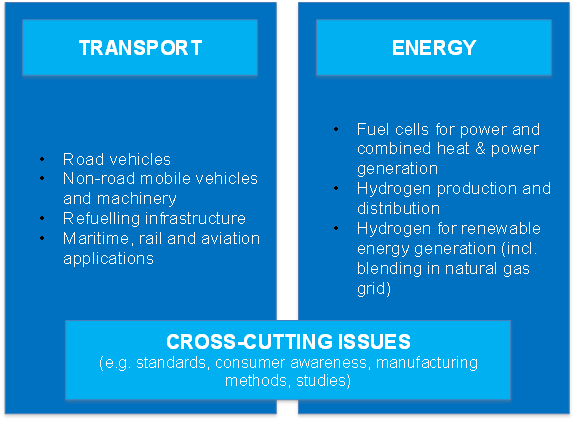Vision 2020
To develop by 2020 to the point of market readiness a portfolio of clean, efficient and affordable solutions that fully demonstrate the potential of H2 as an energy carrier and fuel cell as energy convertor, as part of an energy system that integrates sustainable solutions and energy supplies with low carbon stationary and transport technologies.
Objectives:
The FCH 2 JU shall have as strategic objective to demonstrate by 2020 fuel cell and hydrogen technologies as one of the pillars of future European energy and transport systems, making a valued contribution to the transformation to a low carbon economy by 2050.
It shall, in particular:
- reduce the production cost of fuel cell systems to be used in transport applications, while increasing their lifetime to levels competitive with conventional technologies,
- increase the electrical efficiency and the durability of the different fuel cells used for power production, while reducing costs, to levels competitive with conventional technologies,
- increase the energy efficiency of production of hydrogen mainly from water electrolysis and renewable sources while reducing operating and capital costs, so that the combined system of the hydrogen production and the conversion using the fuel cell system is competitive with the alternatives available in the marketplace;
- demonstrate on a large scale the feasibility of using hydrogen to support integration of renewable energy sources into the energy systems, including through its use as a competitive energy storage medium for electricity produced from renewable energy sources;
- reduce the use of the EU defined "Critical raw materials", for instance via low or platinum free resources and through recycling or reducing or avoiding the use of rare earth elements.
Programme
The FCH 2 JU programme of research and innovation is structured around two research and innovation Pillars dedicated to Transportation and Energy Systems. Overarching projects integrating both transport and energy technologies and a cluster of Cross-cutting research activities complement these two Pillars.
The Transportation Pillar encompasses all aspects of hydrogen utilisation in transportation including FCEVs as well as non-road, train, maritime and aviation applications, in addition to the required Hydrogen Refuelling Station infrastructure for refuelling these vehicles and systems.
The Energy Pillar will support projects in four areas:
- Hydrogen production for energy storage and grid balancing from renewable electricity – including large ‘green’ hydrogen production, storage and re-electrification systems. The initial focus will be on the role hydrogen can play in the integration of renewable energy sources in the grid.
- Hydrogen production with a low carbon footprint from other resources – whereby different hydrogen pathways will be developed and if appropriate demonstrated.
- Fuel cell systems for CHP and Power only – covering the technical developments necessary to reduce costs, increase lifetime and improve performance.
- Hydrogen storage, handling and distribution – to allow storage of hydrogen at central production plant and distribution to the customer base.
It is envisaged that Overarching projects will be supported by the FCH 2 JU to demonstrate the inter-operability and the synergies between the two Innovation Pillars.
Cross-cutting research and development projects will support and enable the Transportation and Energy Pillars and facilitate the transition to market for FCH technologies

